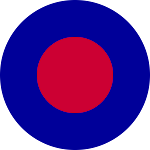
and Crossover Turns
As our Royal Naval Air Squadron, No: 805, flying Seafire XV fighters, readied for imminent departure for the Pacific war, most of our flying time was in what was called ‘the loose open-finger formation’ ; the four aircraft of the formation taking positions similar to the four finger tips of a spread out hand.
Being spread out like this meant that each pilot could keep in formation but be far enough from the other aircraft in the flight to allow him to safely keep his head moving around in order to search the surrounding sky. I always flew as the flight’s number four aircraft, the little finger tip, and two aircraft away from the leader.
When we closed up into the alternate ‘tight box’, diamond-shaped formation, my position was right behind and a little lower than our leader’s number one position. Normally the number two aircraft was on the leader's right (starboard) wing and number three on the leader's left (port) wing.
When in open finger configuration and the leader signalled the formation to change course by more than about twenty-five degrees we used a manoeuvre called a crossover turn. This was an effort to ensure that each aircraft used the same amount of fuel during a long patrol. Because if a wide circular patrol of an area required a series of turns all to port, or all to starboard, to be made the aircraft on the inner or port (or starboard) side has to reduce power to keep position in relation to the leader. Whereas the aircraft on the other, outer side of the turn have to increase their power to keep in place when travelling along their extended turning arcs. This involves several propeller speed adjustments, and more importantly, often some throttle adjustments, each of which, even if very minor, cause the engine to gulp substantial quantities of fuel. Therefore, after an hour or more, the aircraft on the outside of the turns have considerably less fuel left in their tanks than the aircraft on the inside of the turns. This leads to the formation's effective patrol duration being shortened for the whole flight of four aircraft.
To negate this effect, ‘crossover turns’ would be used. These required the outside aircraft to lose just a few feet of height and pass slowly below the leader while the inside aircraft went down a few feet further in order to slide under both of them, and for me to go down even further and pass below all three of the other turning aircraft. In this way, sliding the formation inside out, as it were, all the aircraft traversed approximately the same radius of turn and ideally had no significant engine throttle adjustments to make.
When the turn was completed, the finger formation was regained but was now reversed, with numbers two and three in exchanged positions and number four now on the other furthest side of the formation. After some practice, and I presume a few more white hairs on the leader's head, it worked quite smoothly.
Another Tricky Manoeuvre
While in our open battle formation, we would practise breaking to port or starboard. With plenty of space between our Seafires, we could all watch out for enemy bandits. As soon as any member of the flight saw a bandit coming up on the port side, he was instructed not to waste time reporting the same to the leader but to immediately shout: ‘C Flight. Break Port. Break, Port. Go!’
At this, all pilots immediately banged the control column to port, slammed the pitch lever and throttle fully open and then violently tugged the stick back into the stomach. This resulted in four aircraft all madly banked into a vertical maximum 180-degree turn at full power. As this exercise turned out best if every aeroplane turned in the same direction, we practised knowing which way was port and which way was starboard to a very considerable extent. And then some.


Thanks for the blog. Makes me excited just thinking about your flying!
ReplyDeleteMartin: Thanks for your comment. JO
ReplyDelete